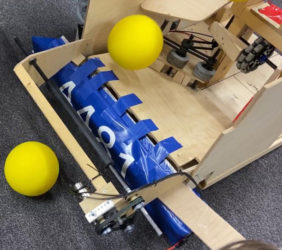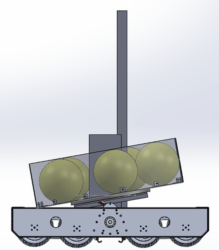2020 – WEEK 3, Wheel of Doom or Wheel of Death?
Team Rembrandts is busy developing and testing the robot for the FIRST 2020 competition: Rise, the force is building. In the meantime, we are already in the third week and the deadlines are getting closer. The VIP reveal is on 13-02-2020, then the robot must be ready. Soon after this reveal, the robot must be ready for shipment to the USA.
Here is a brief impression of the progress as it can be read on the blog site of the 2020 season.
WoD – Wheel of Doom or Wheel of Death?
Monday during the team evening we’ve given the WoD concept once last try to succeed and if we weren’t happy enough by it’s performance we would move on to the different concept.
Anti Jam Code – 1 Powercell
Anti Jam Code – 5 Powercells
No Pockets + Omni
No Pockets + Brush
No Pockets + “Spinning” Omni
WoD Decision Time:
- Does it work? – Yeah-kinda-ish
- Do we like the performance? – Dumping 5 powercells can be tricky but intake a sequence of powercells is doable
- Is it fast enough? – Full field cycle, yeah probably. In the clean up roll/close shots, probably not yet
- Do we already have a shooter that can handle 5 balls in ~0.5 second? – Nope not really…
- Are we confident enough we could design the final iteration now in order to have a working robot within a week from now? – Probably not
- What other sub systems are depending on the WoD? – Intake & climbing heavily; powercell intaking over the bumper vs. raising it higher to roll/dump/fall in the WoD and fitting a shooter & climbing in the middle of the WoD will be difficult to package. Shooter and Control Panel are trivial in a way that the Control Panel system can be integrated somewhere in both concepts. And the shooter has a mounting point where a powercell will enter so should be able to fit on both concepts.
Decision:
The WoD draws lots of attention and interest within the team. We’re in love with the concept but we don’t feel we are far enough in performance to use it for week 1. Since all other subsystems depend on the WoD so much we decided to go for a “safer/easier” concept route which will allow the team to keep working on subsystems.The WoD will be continued by a couple students and mentors. We’d love to have it working at some point that it’s fast enough and we’re happy with it. It might end up on our robot for Detroit Worldchampionship
Current WoD ideas are to move the shooter away from the middle, creating space in the center for a smaller column/tower and to possibly mount the climber. The shooter could be on the back or above a powercell maybe and by slightly tilting the WoD the powercells will roll towards the back creating space in the front.
We noticed that dropping in 3-4 powercells is easy but getting the 5th in position is difficult. See current idea below:

We will be proceeding with the concept below:
- Pivoting intake – #254 2017 style:
2 x 775pro 4:1, 2x 40mm (~1.6") OD dead axle rollers. - Storage – #6135 2020 style:
3 x 3" wheels. Swappable between colson or compliant wheels to test. Wheels will have different ratios to make sure the wheel closest to the shooter hole will spin faster than the outer wheels. Storage slope of 15 degrees and 4" wheel to suck the powercell through the hole into the shooter - Shooter:
Offset to the right of the robot. 2" OD AM Stealth 4" wide kicker drum > individually powered by a 775pro. Shooter drum will be 4" OD, fairlanes or AM Stealth wheels and a external flywheel eventually powered by 2 NEO's 1:1. 2 position hood with ~15 degree angle and ~60 degree angle > Wall shot and longer shots with varying RPM - Climber:
Centered in the middle of the robot. 2 or 3 stage linear tube. Testing this weekend with 2 stage, string and spring/tubing concept. Similar as the #118 Everybot 2020. Eventually package it into a 3 stage arm with constant force springs winched through a custom neo gearbox and a ~ 25mm/1" drum. - Control Panel:
Pivoting wheel which allows to be tucked down to driver through the trench. Rev color sensor from below
Other decisions:
- If driving below the trench hurts the climbing capabilities and packaging they’re allowed to exceed the trench height for week 1. All other sub systems need to be designed to be able to drive underneath the trench.
- Switching from 6 NEO Drivetrain to 4 Neo Drivetrain. With the compressor and Limelight plugged in the PDP we were cutting it very close on PDP slots. 4 Neo’s will be plenty of power and giving us the capabilities of adding a extra kicker motor for example.
That’s it basically in a nutshell.
The team has worked hard to CAD the entire robot in a couple days, hopefully have our prototypes up and running by this weekend to have a better and improved integrated version of the one pictured above.
I’ll post screenshots of the CAD once it’s ready.
Follow here all proceedings of team Rembrandts on their blog.

 Current WoD ideas are to move the shooter away from the middle, creating space in the center for a smaller column/tower and to possibly mount the climber. The shooter could be on the back or above a powercell maybe and by slightly tilting the WoD the powercells will roll towards the back creating space in the front.
Current WoD ideas are to move the shooter away from the middle, creating space in the center for a smaller column/tower and to possibly mount the climber. The shooter could be on the back or above a powercell maybe and by slightly tilting the WoD the powercells will roll towards the back creating space in the front.




